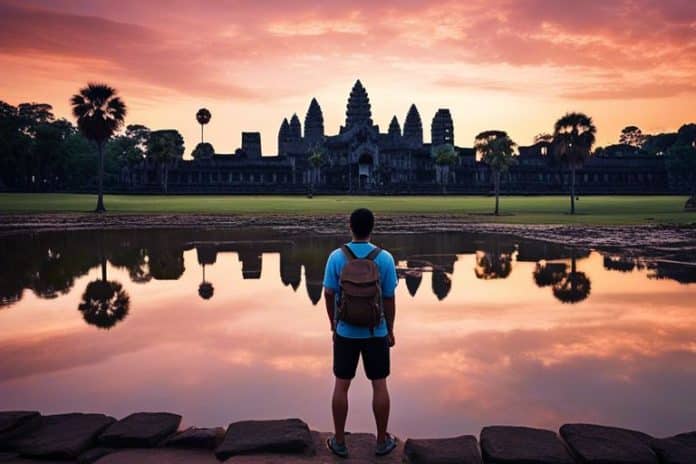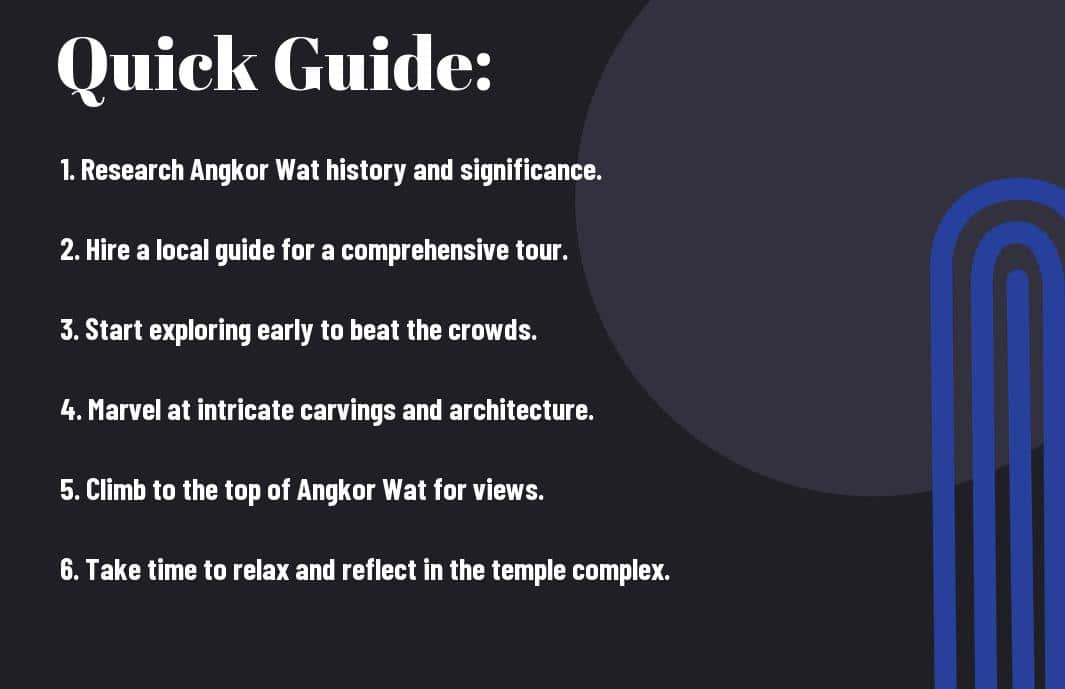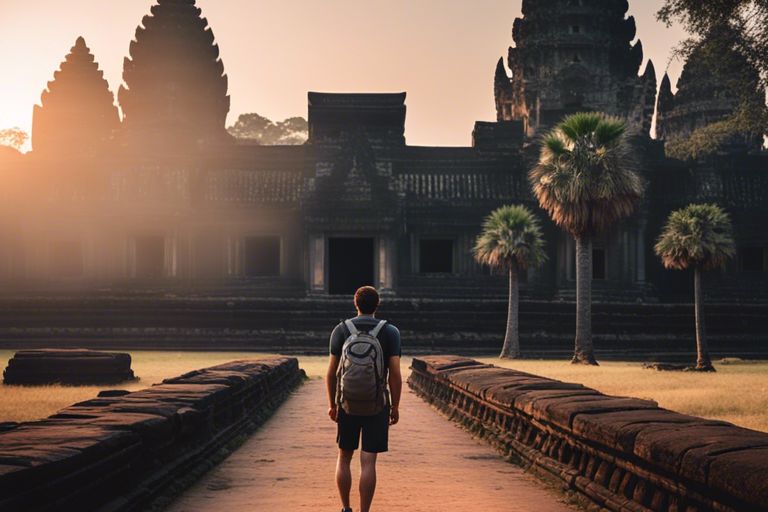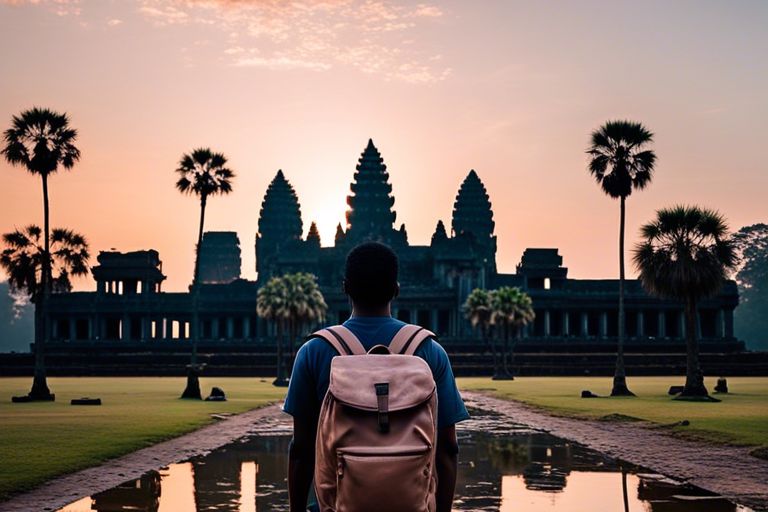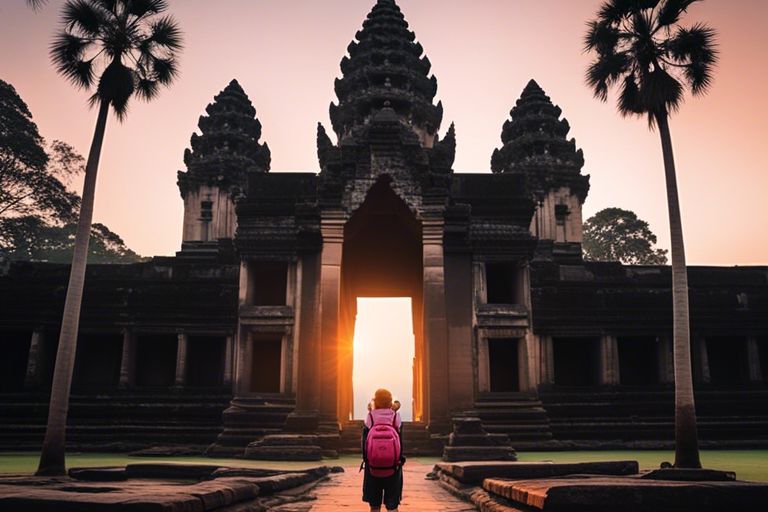This monumental guide will navigate you through the intricate maze of Angkor Wat, a UNESCO World Heritage site in Cambodia that is a must-visit for all history and architecture enthusiasts. Angkor Wat, the largest religious monument in the world, encompasses a sprawling complex of temples, shrines, and ancient structures that date back to the 12th century. Exploring these ancient ruins is a once-in-a-lifetime experience that requires careful planning and preparation to truly appreciate the grandeur and historical significance of this incredible site.
From navigating the sprawling grounds to avoiding tourist crowds, this guide offers crucial tips and tricks for making the most of your visit to Angkor Wat. We will explore into the hidden secrets of the temples, the best times to visit to avoid the scorching heat, and the importance of respecting the local culture and heritage while exploring this sacred site. Whether you’re a seasoned traveler or a first-time visitor, this guide will ensure that your journey through the ancient ruins of Angkor Wat is memorable and enriching.
Prepare to be awe-struck by the sheer magnificence of Angkor Wat as you uncover its mysteries and marvel at its intricate carvings and architectural wonders. So, fasten your seatbelt and get ready for an epic adventure as we take you on a journey through one of the most captivating historical sites in the world. Follow our expert advice and you’ll soon find yourself immersed in the fascinating history and culture of Angkor Wat, ticking off a significant item from your travel bucket list along the way.
Key Takeaways:
- Plan your visit during the shoulder seasons: The best time to explore Angkor Wat is during the shoulder seasons of April-May and October-November to avoid the crowds and extreme weather.
- Hire a knowledgeable guide: To truly appreciate the history and significance of Angkor Wat, consider hiring a local guide who can provide valuable insights and information about the ruins.
- Start early to avoid crowds: Begin your day at Angkor Wat before sunrise to witness the breathtaking sunrise over the temple and explore the complex before the crowds arrive.
- Respect the rules and culture: Be mindful of the dress code, rules, and cultural norms while visiting Angkor Wat to show respect for this ancient site and the local community.
- Stay hydrated and wear comfortable clothing: Angkor Wat is a vast complex with a lot of walking involved, so wear comfortable shoes, dress appropriately for the weather, and stay hydrated throughout your visit.
- Explore beyond the main temple: While Angkor Wat is the most famous temple, don’t miss out on other equally impressive temples nearby, such as Ta Prohm and Bayon, to fully experience the wonders of the Angkor Archaeological Park.
- Support sustainable tourism: Contribute to the preservation of Angkor Wat by supporting local businesses, being mindful of your impact on the environment, and respecting the historical site during your visit.
Preparing for Your Adventure
There’s what’s the best way to visit Angkor Wat? Hire a guide to make the most of your experience exploring the ancient ruins of Angkor Wat. A knowledgeable guide can provide you with historical context, cultural insights, and help navigate the vast archaeological site. Additionally, they can help you avoid crowds and discover hidden gems off the beaten path. Make sure to book your guide in advance to secure the best experience possible.
Understanding the Types of Ancient Ruins in Angkor Wat
- Temples: These religious structures are the most iconic and well-preserved ruins in Angkor Wat.
- Palaces: Once grand royal residences, these ruins offer a glimpse into the ancient Khmer civilization.
- Reservoirs: These man-made water bodies served as irrigation systems for the surrounding area.
- Gateways: Impressive entrances to the temples, often adorned with intricate carvings and sculptures.
- Terraces: Elevated platforms used for ceremonies or viewing performances.
This
| Temples | Religious structures |
| Palaces | Royal residences |
| Reservoirs | Irrigation systems |
| Gateways | Impressive entrances |
| Terraces | Elevated platforms |
Factors to Consider When Planning Your Trip
- Weather: The best time to visit Angkor Wat is during the dry season from November to April to avoid monsoon rains.
- Crowds: Plan your visit early in the morning or late in the afternoon to avoid the peak tourist hours.
- Transportation: Arrange for a reliable transportation service to take you around the vast complex.
When considering factors to consider when planning your trip, weather plays a crucial role in ensuring an enjoyable experience. Recognizing the seasons and planning accordingly can make a significant difference in your visit. Additionally, being mindful of peak tourist times and arranging transportation in advance can help streamline your exploration of the ancient ruins.
- Weather: Consider the seasons and avoid visiting during heavy rainfall to make the most of your trip.
- Crowds: Plan your itinerary to visit popular sites during off-peak hours for a more peaceful experience.
- Transportation: Choose a reliable mode of transport to navigate the expansive archaeological site comfortably.
Step-by-Step Guide to Exploring Angkor Wat
Now, let’s break down the necessary steps to successfully exploring the ancient ruins of Angkor Wat. Whether you are a seasoned traveler or initiateing on your first adventure, this guide will ensure you make the most out of your visit to this UNESCO World Heritage site. From purchasing your Angkor Pass to navigating the temple complex, we’ve got you covered.
Purchasing Your Angkor Pass
Even before you set foot in Angkor Wat, you must purchase an Angkor Pass. These passes are required for entry into the archaeological park and come in different durations – 1-day, 3-day, and 7-day options. The passes can be bought at the official ticket office and must be carried with you at all times while exploring the temples. Make sure to bring along cash in USD, passport-sized photos, and be prepared to have your pass checked multiple times throughout your visit.
With the scorching Cambodian sun beating down, it’s advisable to start your temple exploration early in the morning or late in the afternoon to avoid the midday heat. The lines at the ticket office can get long, so aim to arrive early to beat the crowds. Once you have your pass in hand, you are ready to begin your Angkor Wat adventure.
Arriving at Angkor Wat
To reach Angkor Wat, you can hire a tuk-tuk, bicycle, or opt for a guided tour. If you’re looking to capture the iconic sunrise at Angkor Wat, plan to arrive well before dawn to secure a good spot. Remember to dress appropriately, covering your shoulders and knees as a sign of respect for the sacred site. Upon arrival, you will be greeted by the vast moat and iconic entrance towers that lead to the main temple complex.
To fully immerse yourself in the history and grandeur of Angkor Wat, consider hiring a knowledgeable guide to provide insights into the temple’s architecture, symbolism, and history. Navigating the sprawling grounds can be overwhelming, but with a guide, you can gain a deeper understanding of this ancient wonder. Take your time to explore the intricate carvings, galleries, and towers that make Angkor Wat a must-visit destination.
Maximizing Your Experience
Tips for a Fulfilling Visit
After exploring the ancient ruins of Angkor Wat, it’s important to make the most out of your visit to this mesmerizing destination. Here are some tips for a fulfilling experience:
- Start Early: Avoid the crowds and witness the sunrise over Angkor Wat by arriving early in the morning.
- Stay Hydrated: The tropical climate can be exhausting, so make sure to drink plenty of water throughout your visit.
- Respect the Sacred Sites: Angkor Wat is a place of great historical and religious significance, so remember to dress modestly and behave respectfully.
- Engage with Locals: Interact with the friendly locals to gain insights into the rich culture and history of Cambodia.
- Take Breaks: With a vast area to cover, it’s important to pace yourself and take breaks to fully appreciate the beauty of the temples.
The Pros and Cons of Guided Tours Versus Independent Exploration
With various ways to explore Angkor Wat, it’s crucial to consider the pros and cons of guided tours versus independent exploration:
| Guided Tours | Independent Exploration |
| Expert knowledge from guides | Freedom to explore at your own pace |
| Convenience of organized itinerary | Ability to customize your visit |
| Interaction with other travelers | Opportunity for solitude and reflection |
| Less room for spontaneity | Potential for getting lost or missing out on key information |
Fulfilling
When deciding between guided tours and independent exploration at Angkor Wat, it’s important to weigh the pros and cons carefully. Guided tours offer valuable insights from knowledgeable guides and the convenience of an organized itinerary. However, independent exploration allows for the freedom to create a personalized experience and immerse yourself in the serenity of the ancient ruins.
Independent
While guided tours provide a structured experience with expert commentary, independent exploration offers the flexibility to follow your own interests and discover hidden gems at your own pace. It’s important to consider your preferences for learning and adventure before deciding on the best way to explore Angkor Wat. Any trip to Angkor Wat will be an unforgettable journey filled with awe-inspiring moments and historical revelations.
Angkor Wat Through the Ages
The History and Cultural Significance of the Ruins
History reveals that Angkor Wat was built in the early 12th century by King Suryavarman II, dedicated to the Hindu god Vishnu before transitioning to a Buddhist temple by the end of the 12th century. The ancient ruins symbolize the peak of the Khmer Empire’s power and grandeur in Southeast Asia. The site covers over 400 acres and includes various temples, reservoirs, and causeways, reflecting the empire’s sophisticated urban planning and engineering abilities.
Angkor Wat holds immense cultural significance as a UNESCO World Heritage Site and represents a harmonious blend of Hindu and Buddhist architecture. The site’s intricate bas-reliefs and carvings depict epic tales from Hindu mythology and historical events, providing valuable insights into the Khmer Empire’s religious beliefs and societal structures. The ruins stand as a poignant reminder of a bygone era, inviting travelers to immerse themselves in the rich history and cultural heritage of Cambodia.
Exploring the ruins of Angkor Wat offers a unique opportunity to witness the legacy of a once-mighty empire that flourished over a thousand years ago. The site’s enduring presence amidst the lush Cambodian jungle evokes a sense of mystery and wonder, drawing visitors from around the world to marvel at its architectural splendor and historical significance.
The Architecture and Art of Ancient Khmer Empire
Now, the intricate architecture and artistry of the ancient Khmer Empire are prominently showcased in Angkor Wat’s structures. The temple complex’s central tower represents Mount Meru, the cosmic center of the universe in Hindu mythology, while the surrounding moat symbolizes the oceans. The meticulous design and layout of the temple complex reflect the Khmer Empire’s advanced knowledge of astronomy and mathematics.
For instance, the temple’s west-facing orientation is believed to symbolize death, as the sun sets in the west, consistent with Hindu funeral practices. The bas-reliefs adorning the walls depict scenes from Hindu epics such as the Ramayana and Mahabharata, highlighting the empire’s religious fervor and artistic mastery. Despite facing natural threats and human intervention over the centuries, the impressive architecture and exquisite artistry of Angkor Wat continue to captivate visitors with their timeless beauty and cultural significance.
Adventures Beyond Angkor Wat
For A New Luxury Way To Visit Angkor Wat – Forbes, the ancient ruins of Angkor Wat are just the beginning of the incredible adventures that await in Cambodia. Beyond the iconic temples, there are a plethora of nearby attractions and experiences that will enrich your travel bucket list. Whether you’re a history buff, adventure seeker, or culture enthusiast, there is something for everyone to explore in this enchanting region.
Types of Nearby Attractions and Experiences
- Nature and Wildlife: Explore the lush landscapes and diverse wildlife of Cambodia by visiting the Phnom Kulen National Park or taking a boat ride on the Tonle Sap Lake.
- Adventure Activities: For thrill-seekers, commence on a zip-lining adventure through the jungle or go quad biking around the countryside for an adrenaline-fueled experience.
- Cultural Immersion: Dive deep into the local culture by participating in a traditional Khmer cooking class, visiting local markets, or witnessing a traditional Apsara dance performance.
- Rural Village Visits: Gain insight into the daily lives of rural Cambodians by taking a guided tour of nearby villages, interacting with locals, and supporting community-based tourism initiatives.
- Historical Sites: Discover other ancient temples and ruins beyond Angkor Wat, such as Bayon Temple, Ta Prohm, and Banteay Srei, each with its own unique stories and architectural wonders.
With a myriad of options to choose from, travelers can customize their itineraries to suit their interests and preferences. Whether you’re looking to connect with nature, immerse yourself in local culture, or unravel more historical mysteries, the area surrounding Angkor Wat offers a wealth of opportunities for unforgettable experiences. Perceiving the region beyond its famous temples is imperative to truly appreciate the wonders of Cambodia.
Responsible Tourism and Supporting the Local Economy
Now, let’s examine into the importance of responsible tourism and supporting the local economy when exploring the ancient ruins of Angkor Wat and its surrounding areas. Tourism plays a significant role in Cambodia’s economy, providing jobs and income for many local communities. By choosing sustainable tour operators and engaging in ethical travel practices, visitors can help preserve the environment and empower local residents.
Tourism has the power to positively impact communities by contributing to conservation efforts, supporting cultural heritage preservation, and fostering sustainable development. However, it is crucial to be aware of the potential negative impacts of mass tourism, such as littering, cultural exploitation, and habitat destruction. Responsible travelers should prioritize eco-friendly accommodations, support local businesses, and respect the traditions and customs of the Cambodian people to ensure a positive and meaningful travel experience.
Savoring the Local Cuisine
A Guide to Cambodian Dishes and Delicacies
Now, when exploring the ancient ruins of Angkor Wat, it is important to experience the rich and diverse Cambodian cuisine. Cambodian dishes are known for their bold flavors, fragrant spices, and fresh ingredients. Some of the must-try dishes include Fish Amok, a coconut milk-based curry steamed in banana leaves, and Lok Lak, a stir-fried beef dish served with a tangy dipping sauce. Don’t miss out on trying Num Banh Chok, rice noodles topped with a fish-based gravy and fresh herbs.
Moving on to Cambodian delicacies, make sure to sample the exotic options such as fried spiders or red tree ants. These unique dishes may seem daunting at first, but they offer a true taste of Cambodia’s culinary traditions. For those with a sweet tooth, indulge in traditional desserts like Num Kroch, sweet rice cakes coated in palm sugar, or Num Plae Ai, a sticky rice and coconut milk pudding.
Tips for Finding the Best Local Eateries
Some of the best local eateries can be found off the beaten path, away from the touristy areas. To discover authentic Cambodian flavors, venture into the bustling markets and side streets where the locals eat. Look out for small family-run restaurants or street food vendors serving up traditional Cambodian dishes with fresh, high-quality ingredients. Don’t be afraid to try something new and ask for recommendations from the locals.
Assume that the best local eateries may not have fancy decor or English menus, but the authentic flavors and warm hospitality more than make up for it. Be adventurous and open-minded when exploring the local food scene in Cambodia. Remember to always practice caution with street food and ensure that the food is cooked properly before indulging.
- Avoid eating raw or undercooked meats
- Drink bottled water to stay safe
- Trust your instincts when choosing where to eat
Tips for Photography Enthusiasts
Many visitors who initiate on a journey to explore the ancient ruins of Angkor Wat are photography enthusiasts looking to capture the beauty and mystique of this UNESCO World Heritage site. To make the most of your photography experience at this iconic destination, consider the following tips:
- Plan your visit during optimal lighting conditions to capture the intricate details and stunning architecture of the temples.
- Use a wide-angle lens to capture the grand scale of the temple complexes and intricate carvings.
- Take advantage of the golden hours of sunrise and sunset for soft, warm lighting that enhances the beauty of Angkor Wat.
Knowing these tips will help you elevate your photography game and come away with stunning shots to cherish for years to come.
Capturing the Magnificence: Types of Photographic Opportunities
Magnificence
When exploring the ancient ruins of Angkor Wat, you will be presented with a plethora of photographic opportunities. From the intricate carvings on the temple walls to the majestic silhouette of Angkor Wat against the backdrop of a colorful sunrise or sunset, there is no shortage of subjects to capture. Here are some types of photographic opportunities you can expect:
- Architectural details: Capture the intricate carvings and architectural details of the temples.
- Landscape shots: Take wide-angle shots to showcase the grandeur of the temple complexes and surrounding jungle.
- Portrait photography: Capture the essence of local life with candid shots of monks, vendors, and visitors at the temples.
After exploring these different types of photographic opportunities, you will have a well-rounded collection of images that capture the magnificence of Angkor Wat from various perspectives.
The Dos and Don’ts of Photography in Sacred Spaces
Now, when it comes to photographing in sacred spaces like Angkor Wat, it’s crucial to be mindful of the cultural sensitivities and rules surrounding photography. Here are some dos and don’ts to keep in mind:
Photography in sacred spaces can be a sensitive subject, so it’s important to respect the rules and guidelines set by the local authorities. Avoid using flash photography in areas where it may disturb worshippers or damage delicate artwork. Always ask for permission before taking close-up shots of people, especially monks or locals. Be mindful of your surroundings and avoid disrupting religious ceremonies or rituals with your camera.
Knowing these dos and don’ts will help you navigate the complex world of photography in sacred spaces with respect and consideration.
Common Challenges and How to Overcome Them
Dealing with the Heat and Humidity
All visitors to Angkor Wat will inevitably have to contend with the intense heat and humidity that pervades the region, especially during the summer months. It is crucial to come prepared with proper sun protection such as sunscreen, a wide-brimmed hat, and sunglasses to shield yourself from the scorching sun. Additionally, wearing light, breathable clothing and staying hydrated by drinking plenty of water is imperative to prevent heat-related illnesses.
Dealing with the heat and humidity can be challenging, but taking regular breaks in the shade and planning your visit early in the morning or later in the afternoon when temperatures are slightly cooler can make a significant difference. Acclimatizing yourself gradually to the climate upon arrival can also help your body adjust more easily to the heat and humidity.
While exploring the ancient ruins, be mindful of the signs of heat exhaustion such as dizziness, fatigue, and excessive sweating. Listen to your body and take necessary precautions to avoid heat-related emergencies. By being prepared and vigilant, you can fully enjoy your visit to Angkor Wat despite the challenging weather conditions.
Navigating Crowds and Personal Safety
The bustling crowds at Angkor Wat can sometimes detract from the serenity of the ancient ruins and pose potential safety concerns for visitors. To navigate through the crowds effectively, consider visiting popular sites early in the morning or late in the afternoon when tourist numbers are lower. This strategic timing can help you appreciate the beauty of the temples without feeling overwhelmed by the crowds.
Personal safety is paramount when exploring the expansive temple complex. Be wary of pickpockets in crowded areas and keep your belongings secure at all times. It is also advisable to hire a reputable tour guide who can provide valuable insights into the history and significance of the ruins while ensuring your safety throughout the visit.
Staying aware of your surroundings and following safety guidelines can help you make the most of your experience at Angkor Wat. By taking precautionary measures and being mindful of potential risks, you can explore the ancient ruins with peace of mind and create lasting memories of this extraordinary travel bucket list adventure.
Reflections and Responsible Tourism
The Impact of Tourism on Angkor Wat
Once again, it is crucial to reflect on the impact of tourism on ancient sites like Angkor Wat. While tourism can bring economic benefits to the local community and help preserve these historical landmarks, it also poses significant challenges. The surge in visitors has put immense pressure on the infrastructure and environment surrounding Angkor Wat, leading to issues such as overcrowding, pollution, and wear and tear on the ancient structures.
Furthermore, irresponsible tourism practices, such as vandalism, looting, and disrespectful behavior by visitors, have threatened the integrity and preservation of Angkor Wat. These negative impacts not only degrade the site’s cultural and historical significance but also jeopardize its long-term sustainability for future generations to appreciate and learn from.
It is crucial for visitors to be mindful of their actions and strive to be responsible tourists when exploring Angkor Wat. By understanding the adverse effects of tourism on the site and making conscious choices to mitigate them, travelers can help ensure the preservation and protection of this ancient wonder for years to come.
How You Can Contribute to Preservation Efforts
If you are planning a trip to Angkor Wat, there are several ways you can contribute to preservation efforts and promote responsible tourism practices. One of the most significant ways to support the conservation of Angkor Wat is by respecting the site’s rules and regulations. This includes following designated pathways, refraining from touching or climbing on the temple structures, and avoiding any form of vandalism or littering.
Another way to contribute to preservation efforts is by supporting local initiatives and organizations dedicated to the conservation of Angkor Wat. By donating to reputable causes or volunteering your time, you can directly impact the sustainability of this ancient site and help ensure its protection for future generations to appreciate and enjoy.
If you are passionate about preserving cultural heritage and promoting responsible tourism, consider learning more about the history and significance of Angkor Wat. By educating yourself and others about the importance of conservation, you can inspire positive change and encourage a greater respect for this remarkable UNESCO World Heritage Site.
Final Words
Upon reflecting on how to explore the ancient ruins of Angkor Wat, it is clear that this travel bucket list adventure offers a unique and unforgettable experience for anyone looking to immerse themselves in history and culture. Navigating the vast temple complex requires careful planning and a sense of awe as you discover the intricacies of ancient Khmer architecture. From watching the sunrise over the iconic silhouette of Angkor Wat to exploring the enigmatic faces of Bayon Temple, every moment spent in this UNESCO World Heritage site is sure to leave a lasting impression.
As you commence on this journey, it is vital to respect the significance of these sacred ruins and tread lightly to preserve their beauty for future generations. Engaging with knowledgeable guides can deepen your understanding of Angkor Wat’s rich history and mythological symbolism, enhancing your overall experience. Remember to take your time exploring each temple, allowing yourself to be captivated by the mystical atmosphere that permeates the ancient stone structures.
All things considered, exploring the ancient ruins of Angkor Wat is a transcendent experience that promises to transport you back in time and connect you with the spiritual essence of Cambodia’s past. Whether you are a history enthusiast, a culture lover, or simply a curious traveler, a visit to this architectural marvel should undoubtedly be on your travel bucket list. So pack your bags, prepare your camera, and get ready to commence on an adventure of a lifetime in the heart of Southeast Asia. Angkor Wat awaits, ready to unveil its timeless secrets to those who dare to explore.
FAQ
Q: What is Angkor Wat?
A: Angkor Wat is a famous temple complex in Cambodia that was built in the 12th century and is a UNESCO World Heritage site.
Q: How do I get to Angkor Wat?
A: The nearest city to Angkor Wat is Siem Reap in Cambodia. You can reach Siem Reap by flying into Siem Reap International Airport or taking a bus from other parts of Cambodia.
Q: What is the best time to visit Angkor Wat?
A: The best time to visit Angkor Wat is during the dry season from November to March when the weather is cooler and there is less chance of rain.
Q: Are there entrance fees to visit Angkor Wat?
A: Yes, there are entrance fees to visit Angkor Wat. The fees vary depending on the duration of your visit, with options for one-day, three-day, and seven-day passes.
Q: What should I wear when visiting Angkor Wat?
A: It is recommended to wear modest clothing that covers your shoulders and knees out of respect for the cultural significance of the temple complex. Comfortable walking shoes are also important as you will be exploring a lot on foot.
Q: Are there tour guides available at Angkor Wat?
A: Yes, there are tour guides available for hire at Angkor Wat who can provide you with in-depth knowledge about the history and significance of the temple complex.
Q: What are some other nearby attractions to visit alongside Angkor Wat?
A: Some other nearby attractions to visit alongside Angkor Wat include Angkor Thom, Ta Prohm (the Tomb Raider temple), and Banteay Srei temple with its intricate carvings.
